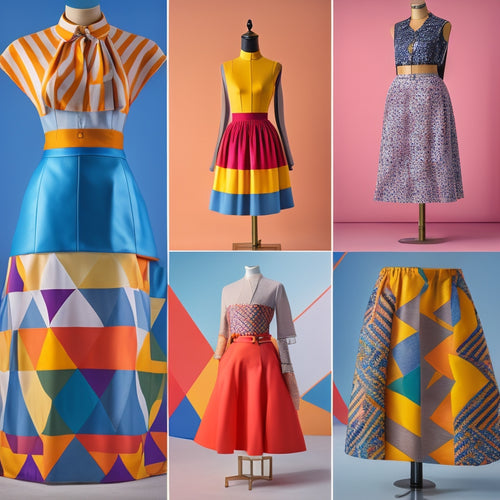What Advanced Training Do Professional Dancers Need?
Share
To take your dancing to the next level, you'll need advanced training that goes beyond the fundamentals, encompassing nuanced aspects such as musicality, cultural context, technical precision, anatomical awareness, and artistic expression. You'll need to master musicality and timing, exploring cultural and historical context to inform your movements. Perfecting isolation and control techniques is essential, as is understanding anatomy and injury prevention to maintain a healthy, capable body. Developing artistic expression and style will set you apart, and it's just the beginning - there's more to explore in the world of professional dance.
Key Takeaways
• Professional dancers need advanced training in musicality and timing to express emotional depth and complexity in their performances.
• They require exploration of cultural and historical context to incorporate diverse styles and techniques into their craft.
• Mastering isolation and control techniques is essential for precision, balance, and stability in complex movements.
• Understanding anatomy and injury prevention is crucial for maintaining flexibility, strength, and proper alignment to prevent injuries.
• Developing artistic expression and style through intentional exploration and emotional connection is vital for crafting unique and impactful performances.
Mastering Musicality and Timing
To enhance your dancing skills, you must develop a keen sense of musicality and timing, as these elements are crucial in expressing the emotional depth and complexity of a choreographed piece.
By mastering musicality, you'll be able to tap into the emotional resonance of the music, allowing you to connect with the audience on a deeper level. One key aspect of musicality is managing polyrhythmic complexity, where multiple rhythms intersect and overlap.
This requires a high level of technical proficiency, as well as a deep understanding of the music itself. To truly excel, you'll need to make micro timing adjustments, subtly adapting your movements to align with the nuances of the score.
This level of precision demands intense focus and practice, but the payoff is well worth it – your performances will be elevated to new heights, and your connection with the audience will be palpable.
Exploring Cultural and Historical Context
As you refine your musicality and timing, you'll find that understanding the cultural and historical context of a piece is equally essential in conveying its emotional resonance and authenticity. Think of it like being a detective, exploring through the past to uncover the hidden gems that make a dance style truly shine.
You'll need to investigate the cultural and historical context of each piece to grasp its essence.
Some key areas to explore include:
-
Folklore Revival: How did traditional folk dances influence the development of modern styles?
-
Imperialism Influence: How did colonialism and imperialism shape the cultural exchange and adaptation of dance styles?
-
Social and Political Movements: How did historical events, like the civil rights movement, impact the evolution of dance?
-
Cultural Fusion: How did different cultures merge to create unique dance styles, like Afro-Caribbean or Indo-Jazz?
-
Artistic Innovations: How did pioneers in dance, like Martha Graham or Alvin Ailey, push the boundaries of traditional styles?
Perfecting Isolation and Control Techniques
You develop mastery over your body by mastering isolation and control techniques, which enable you to execute intricate movements with precision and fluidity. These techniques are essential for professional dancers, as they allow for subtle, nuanced expressions that elevate your performance. By focusing on micro movements, you can refine your gestures and bring depth to your dancing.
| Technique | Description | Benefits |
|---|---|---|
| Isolation | Isolating specific body parts to move independently | Enhances precision and control |
| Core Stability | Engaging core muscles to support movement | Improves balance and stability |
| Micro Movements | Focusing on small, subtle movements | Adds nuance and expression to gestures |
To perfect your isolation and control techniques, practice exercises that target specific muscle groups, such as shoulder rolls, wrist circles, and toe taps. These exercises will help you develop the precision and control needed to execute complex movements with ease. Remember, mastering isolation and control takes time and practice, but the payoff is a more expressive, nuanced performance that will leave your audience in awe.
Understanding Anatomy and Injury Prevention
By grasping the intricacies of human anatomy, you'll better comprehend the mechanical stresses dance movements place on your body, enabling you to take proactive steps in preventing injuries. As a professional dancer, understanding how your body functions will help you identify potential weaknesses and take preventative measures. This knowledge will empower you to make informed decisions about your training, reducing the risk of injury and prolonging your career.
Here are some essential aspects of anatomy to focus on:
-
Flexibility exercises: Increase your range of motion and reduce muscle tension with targeted stretches and exercises.
-
Core strengthening: Develop a strong core to improve balance, stability, and overall dance technique.
-
Joint alignment: Understand how to maintain proper joint alignment to reduce wear and tear on your muscles and joints.
-
Muscle imbalances: Identify and address muscle imbalances to prevent injuries and improve overall performance.
-
Breathing and posture: Optimize your breathing and posture to improve your overall dance technique and reduce fatigue.
Developing Artistic Expression and Style
Developing a distinctive artistic expression and style requires deliberately cultivating your unique voice through intentional exploration of movement, musicality, and emotional connection. You're not just mastering steps; you're crafting a narrative that resonates with your audience.
To do this, you'll need to tap into your Emotional Authenticity, allowing your true self to shine through your performance. This vulnerability is what makes your artistry relatable and impactful.
Vital Storytelling is another essential element in developing your style. You're not just dancing; you're painting a picture with your body, conveying a message that transcends words. Every gesture, every glance, every movement is a brushstroke on the canvas of your audience's imagination.
Frequently Asked Questions
How Do I Balance Rehearsals With Performances and Self-Care?
You masterfully juggle rehearsals, performances, and self-care by deploying time management wizardry and prioritization strategies, ensuring you're not sacrificing sanity for sequins – schedule wisely, and remember, a happy dancer is a healthy dancer!
Can I Still Dance Professionally With a Non-Dance Related College Degree?
You can still dance professionally with a non-dance related college degree, leveraging creative freedom to bridge the gap; the degree's relevance lies in transferable skills, like time management, that enhance your dance career.
Do I Need to Learn Multiple Dance Styles to Be Competitive?
"Are you ready to take your dancing to the next level? Learning multiple styles isn't just a nice-to-have, it's a must-have - think cross training benefits and style versatility. You'll be the ultimate triple threat: flexible, fearless, and in-demand!"
How Can I Network and Find Job Opportunities in the Dance Industry?
You'll boost your career by attending industry events, like festivals and workshops, to connect with influencers, and by crafting a strong online presence, showcasing your skills and style through a professional website and social media profiles.
Are There Opportunities for Professional Dancers Beyond Performing?
"You're not just a dancer, you're a triple threat! Beyond performing, you can pivot to choreographer mentorship, dance advocacy, or even dance education, leveraging your skills to inspire the next generation of movers and shakers."
Related Posts
-

What Makes a Stunning Lyrical Dance Makeup Look?
You craft a stunning lyrical dance makeup look by balancing ethereal, emotive essence with subtle, shimmering accents...
-

Top Geometric Print Skirts to Update Your Wardrobe
To update your wardrobe with stunning geometric print skirts, look for bold colors and unique patterns that turn head...
-

Wireless Bluetooth Speakers With the Longest Battery Life
If you're in the market for wireless Bluetooth speakers with the longest battery life, look for models boasting over ...


